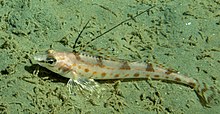Genus of fishes
This article is about the Cottoids. For the wrasse, see
Comb wrasse .
Zaniolepis combfishes , is a genus of marine ray-finned fish , it is one of two genera in the family Zaniolepididae. These fishes are native to the eastern Pacific Ocean . Z. frenata that was a source of food to the Native American inhabitants of San Nicolas Island off the coast of southern California , United States during the Middle Holocene .[ 5]
Taxonomy
Zaniolepis was first proposed as a monospecific genus in 1858 by the French zoologist Charles Frédéric Girard when he described Z. longispinis from Fort Steilacoom on Puget Sound in Washington .[ 6] [ 7] Oxylebiinae , haves been classified as two subfamilies in the Hexagrammidae .[ 4]
Etymology
Zaniolepis is a combination of xanion , which is a Greek word for a comb used to card wool, and lepis , meaning "scale", referring to the overlapping, almost ctenoid scales of Z. latipinnis .[ 8]
Species
The currently recognized species in this genus are:[ 9]
Characteristics
Zaniolepis combfishes have a deep incision in the rear third their dorsal fin and the first 3 spines in the dorsal fin are highly elongated, extremely so in Z. latipinnis . The anal fin contains 3 spines while the first 2 rays in the pelvic fins are long and robust and extend past the origin of the anal fin. The caudal fin truncated.[ 7] [ 9]
Distribution and habitat
Zaniolepis combfishes are found in the eastern North Pacific Ocean from Alaska to Baja California. They are benthic fishes.[ 9]
References
^ Sepkoski, Jack (2002). "A compendium of fossil marine animal genera" . Bulletins of American Paleontology . 364 : 560. Archived from the original on July 23, 2011. Retrieved 2009-02-27 . ^ Richard van der Laan; William N. Eschmeyer & Ronald Fricke (2014). "Family-group names of Recent fishes" . Zootaxa . 3882 (2): 001– 230. doi :10.11646/zootaxa.3882.1.1 PMID 25543675 . ^ a b Eschmeyer, William N. ; Fricke, Ron & van der Laan, Richard (eds.). "Genera in the family Zaniolepididae" . Catalog of Fishes California Academy of Sciences . Retrieved 3 December 2022 .^ a b Catherine W. Mecklenburg & William N. Eschmeyer (2003). "Family Hexagrammidae Gill 1889 Greenlings" (PDF) . California Academy of Sciences Annotated Checklists of Fishes . 2 . ^ Vellanoweth, R. L. & Erlandson, J. M. (1999): Middle Holocene Fishing and Maritime Adaptations at CA-SNI-161, San Nicolas Island, California. Journal of California and Great Basin Anthropology, 21(2): pp. 257-274
^ Eschmeyer, William N. ; Fricke, Ron & van der Laan, Richard (eds.). "Species in the genus Zaniolepis " . Catalog of Fishes California Academy of Sciences . Retrieved 3 December 2022 .^ a b J. S. Nelson; T. C. Grande; M. V. H. Wilson (2016). Fishes of the World 467– 495. ISBN 978-1-118-34233-6 ^ Christopher Scharpf & Kenneth J. Lazara, eds. (11 July 2021). "Order Perciformes: Suborder Cottoidea: Infraorder Zaniolepidoales: Family Zaniolepidae" . The ETYFish Project Fish Name Etymology Database . Christopher Scharpf and Kenneth J. Lazara. Retrieved 3 December 2022 . ^ a b c Froese, Rainer ; Pauly, Daniel (eds.). "Species in genus Zaniolepis " . FishBase

